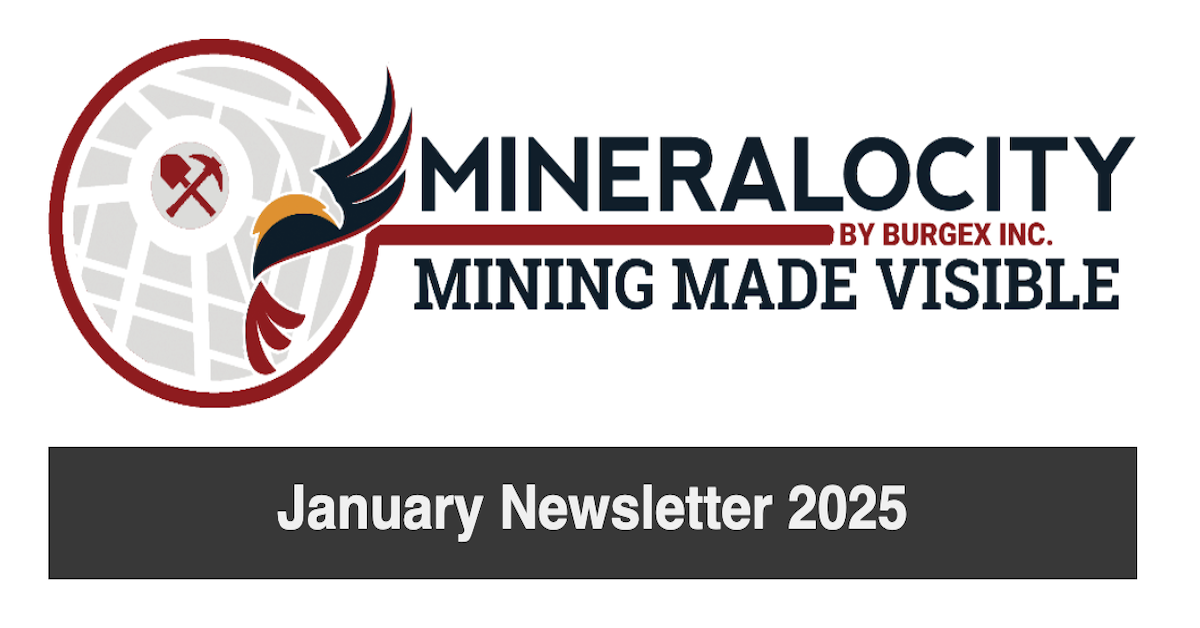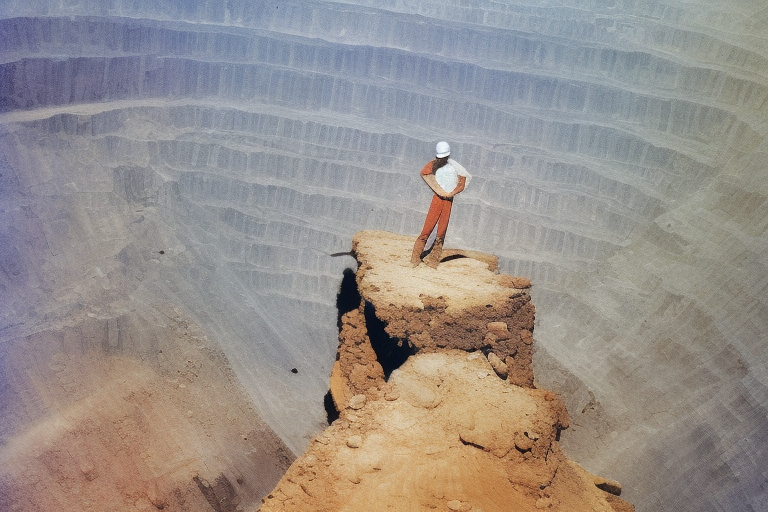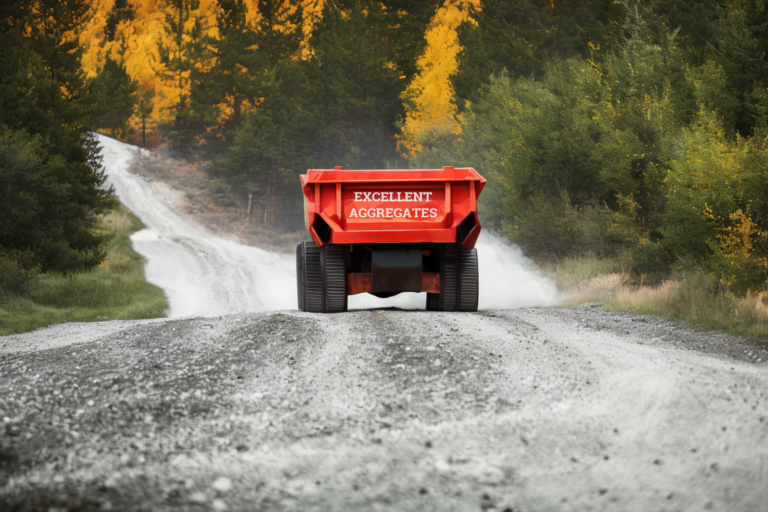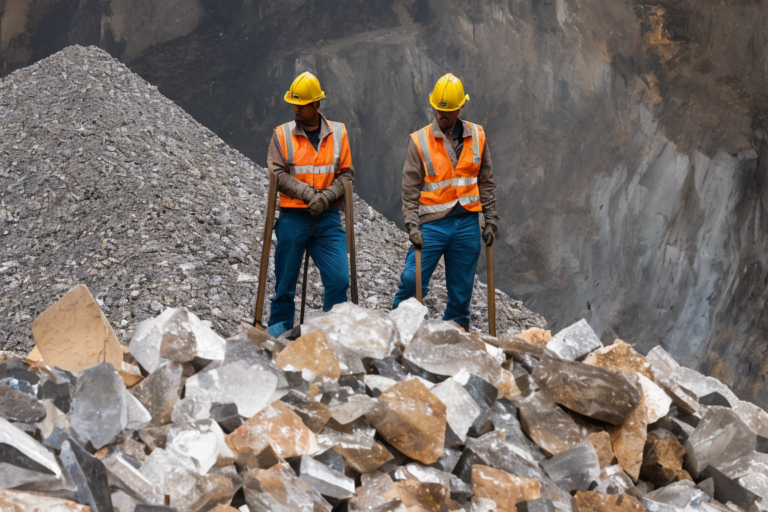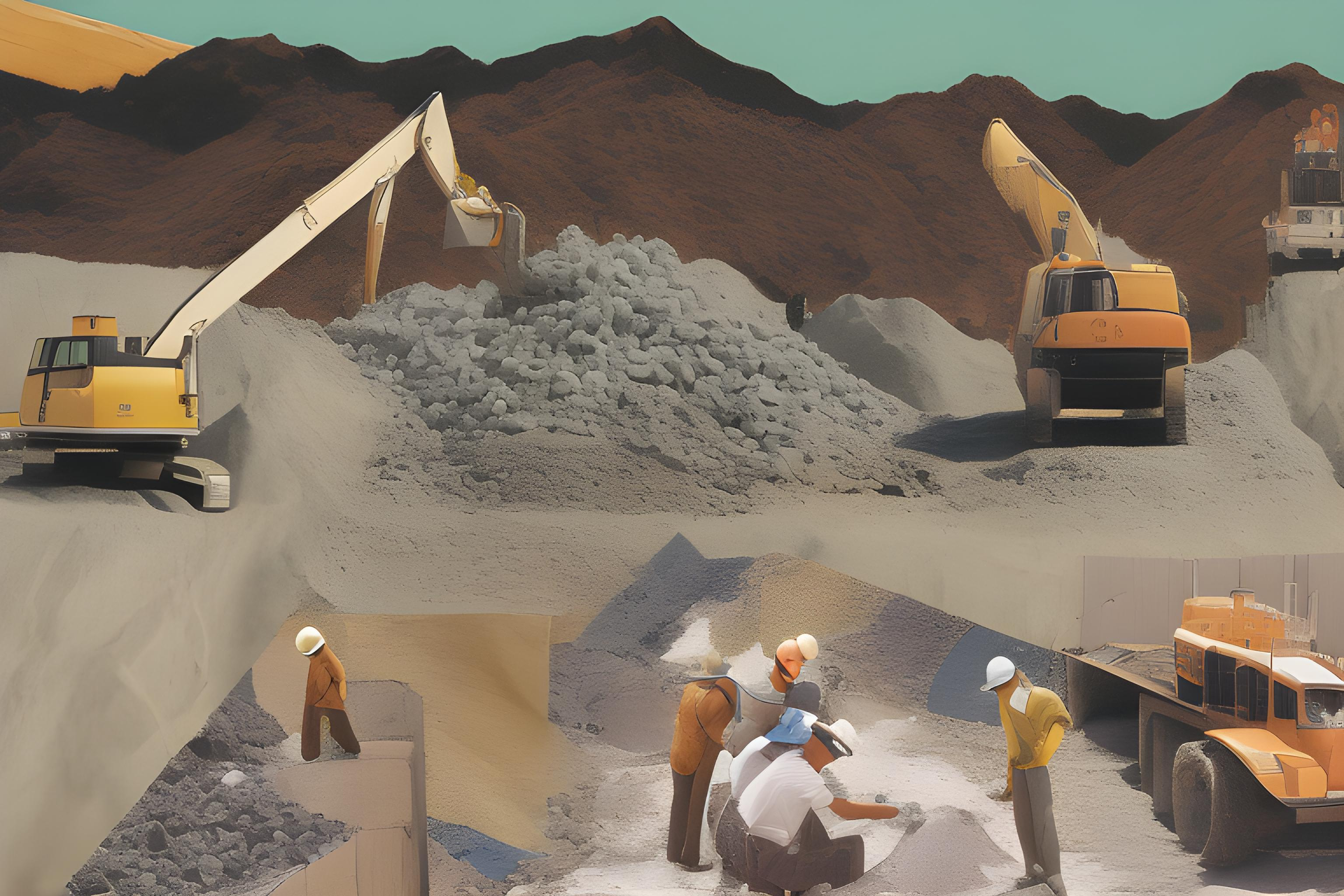Using Data To Make Better Decisions
Contact Us Today
Contact Us Today
Last week, the Mineralocity Aggregates team had the distinct pleasure of touring Calgary Aggregate Recycling Inc., in Calgary, Alberta. The occasion was a special open house hosted by CDE, an Irish company at the forefront of traditional aggregate processing and cutting-edge recycling technology. This experience provided invaluable insights into the sustainable future of aggregate processing and recycling.
Before diving into the tour details, it’s important to understand the role that CDE plays in the aggregate recycling industry. With the motto, “Engineered for a Circular Economy,” CDE is doing more than just pioneering waste recycling; they’re laying the groundwork for a more sustainable future. They specialize in providing wet processing solutions that divert over 20 million tons of waste from landfills annually. Whether it’s construction and demolition waste, contaminated soils, or hydro excavation waste, CDE transforms these materials into valuable construction resources.
During our tour, we were fortunate enough to see the plant process different types of waste, including excavation and hydro excavation waste. The system, efficient and precise, separates the waste into sorted, washed, and screened streams of rock, sand, and fines.
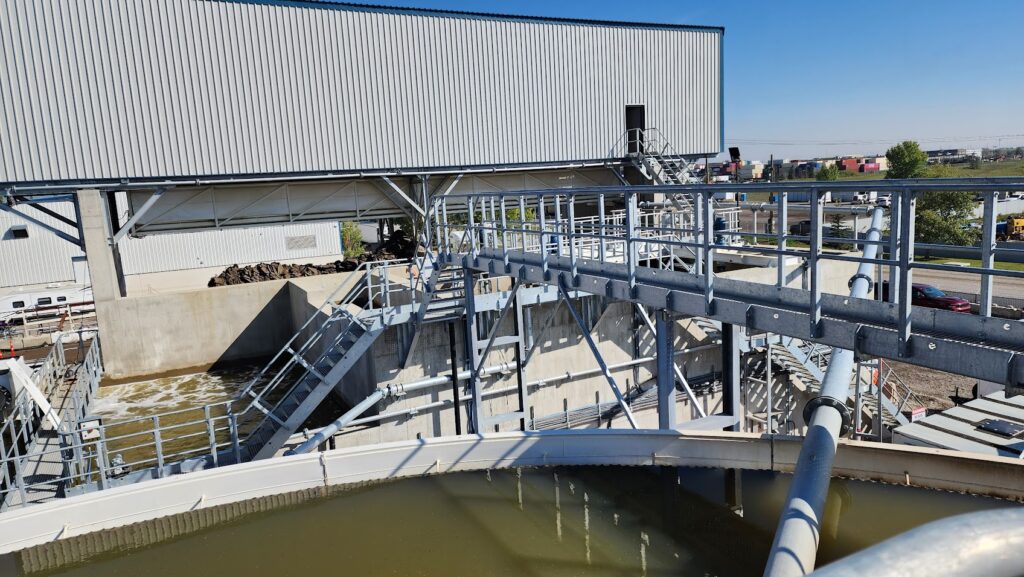
A highlight of the plant’s operation was its closed-loop water system, which recycles ~95% of the water used. This feature not only conserves a critical natural resource but also allows the plant to function with a minimal environmental footprint. This allows for faster permitting and a lower impact footprint.
What stood out during the tour was the plant’s commitment to efficiency. Every aspect of the operation can be monitored from a single dashboard, ensuring that each element runs at peak efficiency to maximize uptime. This is a crucial aspect for any plant that aims to be both profitable and sustainable.
The tour was more than just an educational experience; it was an inspiring vision of the potential that lies ahead. One of the most immediate takeaways was the need to reevaluate our perceptions of waste. Traditionally viewed as something to discard, waste, as demonstrated by Calgary Aggregate Recycling Inc. and CDE, can be a valuable resource.
The advanced technologies we observed have significant scalability and adaptability potential. With CDE’s wet processing solutions capable of diverting over 20 million tons of waste from landfills annually, one can only imagine the global impact if more such facilities were to adopt these technologies. And given that these technologies can be adapted to handle various types of waste—from excavation waste to contaminated soils—it opens doors for widespread industry adoption. We were told that CDE can build these plants to handle as little as 70tph to as much as 700tph. They also offer custom solutions that could potentially be even larger.
While the environmental implications are obvious, there are also substantial economic benefits to consider. The plant’s closed-loop water system, for example, significantly reduces water costs. The ability to monitor every aspect of the operation from a single dashboard allows for real-time decision-making, reducing downtime and boosting profitability.
The success of facilities like Calgary Aggregate Recycling Inc. should encourage policymakers to support sustainable practices in the aggregate industry. By doing so, they can facilitate the transition from traditional waste management to circular economic models that are both profitable and beneficial for the planet.
In a world that’s increasingly cognizant of environmental responsibility, adopting the practices showcased during our tour is more than just good business sense—it’s a societal imperative. Companies that are quick to embrace these technologies not only stand to gain a competitive edge but also become leaders in setting new industry standards.
By embedding these forward-thinking practices into our industry’s operations, we not only mitigate our environmental impact but also create a more resilient, cost-effective, and ultimately more sustainable business landscape. The tour reaffirmed our belief that with the right technologies and practices, the aggregate industry has a bright and sustainable future.
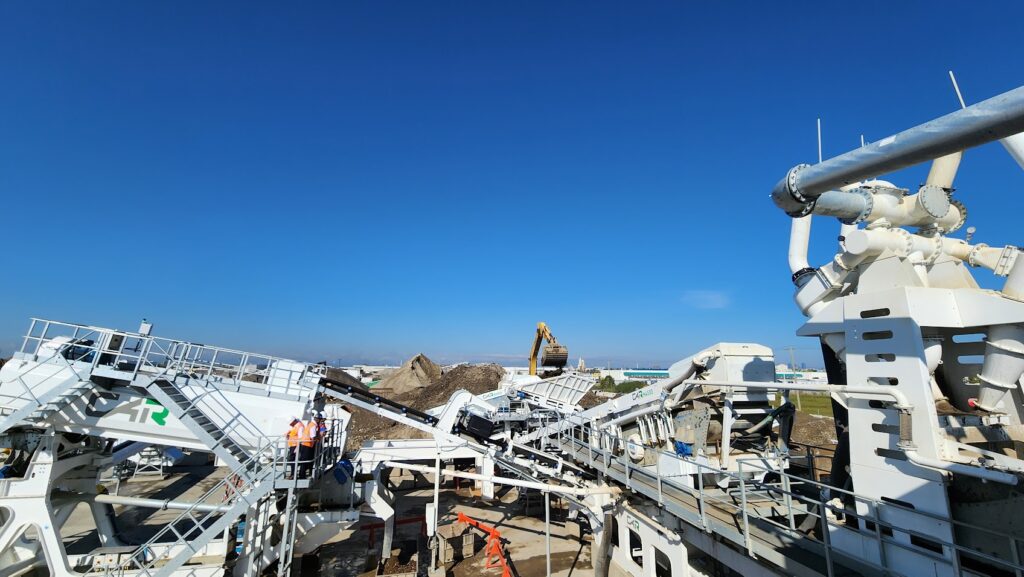
The tour of Calgary Aggregate Recycling Inc. was eye-opening, to say the least. It revealed a glimpse of what is possible when innovation meets sustainability. With companies like CDE leading the way, the future of aggregate recycling is not just promising; it’s imperative. And for teams like ours at Mineralocity Aggregates, it affirms our commitment to be part of this sustainable future.
Navigating the competitive landscape of the construction aggregate industry means being prepared for a multitude of challenges, from new competitors to economic shifts and beyond. Understanding these traditional threats to your market share is vital for long-term success. This article outlines some of these key factors and offers strategies to help you maintain and grow your market share.
The arrival of a new competitor in the construction aggregate industry can significantly impact your business, potentially eating into your market share. These newcomers often come armed with aggressive pricing strategies, innovative products, or even a unique marketing approach, designed to lure away even your most loyal customers.
The first step in effectively countering new competition is recognizing their presence as early as possible. This can be accomplished through consistent market research, watching for permitting applications, monitoring industry publications, and even keeping an ear to the ground among your customer base and suppliers.
Once you’ve identified a new player in the field, a detailed competitor analysis is essential. This will help you understand their strategies, strengths, weaknesses, and most importantly, their potential impact on your market share. Your SWOT (Strengths, Weaknesses, Opportunities, and Threats) analysis should be updated to include this new competitor. This will help you identify any adjustments needed in your own value proposition.
Based on your SWOT analysis, review your value proposition to identify how you can differentiate your offering from the new competitor. This might involve enhancing product features, revising pricing structures, or improving customer service. It’s crucial to remind your customers why they chose your brand in the first place.
The market conditions are ever-changing, especially with a new competitor stirring the waters. Continuously monitor their strategies, customer feedback, and their impact on your market share. This is a dynamic process that will likely require you to adapt your own strategies over time.
Platforms like Mineralocity Aggregates can provide data-driven insights into customer behavior, supply chain dynamics, and market trends. Utilize this data to adapt and refine your strategies for defending your market share against new competitors.
By understanding the strategies and tactics of new entrants, and responding proactively, you can mitigate the impact on your market share and even discover new opportunities for growth.
Local and regional economic conditions can dramatically affect your market share in the construction aggregate industry. Economic downturns often lead to reduced construction activities, while booms can bring about increased competition and higher operational costs. Here’s how to safeguard your market share during such uncertain times.
Be proactive in monitoring key economic indicators relevant to your industry. These might include interest rates, unemployment levels, and construction starts. Understanding these indicators can help you predict how market demand will be affected.
In times of economic instability, a rigid business model can be a liability. Flexibility allows you to quickly adapt to changing circumstances, whether it’s adjusting production levels, diversifying product offerings, or temporarily scaling back on certain operations.
Maintaining a healthy cash flow is crucial, especially during economic downturns. Consider renegotiating terms with suppliers or exploring alternative financing options to bolster your liquidity. This financial cushion can provide you with the room to maneuver when times get tough.
Cost optimization is not merely about cutting expenses; it’s about making your operation leaner and more efficient. This might include improving operational efficiencies or renegotiating contracts with suppliers. Any savings can be redirected to strategies aimed at maintaining or increasing market share.
Utilize risk management tools and strategies to prepare for potential financial downturns. This could include securing long-term contracts with favorable terms or hedging against market variables that could affect your costs, such as fuel prices.
Utilize data analytics platforms like Mineralocity Aggregates to gain insights into customer behavior, pricing elasticity, and market trends. This enables you to make informed decisions and develop adaptive strategies that can weather economic fluctuations.
By being prepared and adaptive, you can better defend your market share when economic conditions shift. Uncertain times often bring both challenges and opportunities—being agile and prepared can help you capitalize on the latter.
The construction aggregate industry often faces dramatic fluctuations in demand due to the cyclical nature of large construction projects. Whether it’s the commencement of a massive infrastructure project or the winding down of a long-term development, these shifts can significantly affect your market share. Here’s how to stay ahead:
Staying informed about local and regional construction activities is essential. Subscribe to industry journals, participate in local business forums, and maintain relationships with key players to gather early intelligence about upcoming projects or project completions.
When you anticipate an increase in demand due to an upcoming project, effective stockpile management becomes critical. You may need to ramp up production in advance to meet this demand, which will also necessitate calculating storage costs and considering the shelf-life of your aggregates.
When faced with a sudden influx of large projects, your operation must be scalable. This could mean leasing additional machinery, hiring temporary labor, or partnering with other producers. Scalability allows you to capitalize on increased demand without overextending your resources.
Large projects might require bulk quantities but at more competitive pricing. Revisiting your pricing strategy in such cases is crucial. Offering tiered pricing or early-bird discounts can not only secure a large project but also protect your market share.
As large projects wind down, demand for aggregates will drop, sometimes significantly. Having a transition plan can help you adjust your production levels and shift your focus to other markets or smaller projects. Failing to prepare for this drop in demand can result in overstock and reduced profitability.
Platforms like Mineralocity Aggregates can offer invaluable insights for predicting future demand patterns. Utilizing predictive analytics helps you prepare for market fluctuations, allowing you to make well-informed decisions regarding production, pricing, and distribution.
By staying proactive and adaptable, you can navigate the often unpredictable tides of project-based demand, defending and even growing your market share in the process.
In a constantly evolving landscape like the construction aggregate industry, defending your market share is a never-ending task. The threats are many and varied—from new competitors disrupting the market to economic uncertainties that can shake even the most stable of businesses. On top of that, the very nature of the industry is such that demand can ramp up or plummet based on the ebb and flow of large construction projects.
Adaptability and proactivity are your best allies in such an environment. Keeping an eye out for new entrants can help you maintain your competitive edge. During uncertain economic times, a well-honed financial strategy is your best defense, helping you to survive and even thrive. Similarly, understanding the dynamics of demand, particularly during the launch or conclusion of major projects, allows for smarter stockpile management, more dynamic pricing strategies, and a better-planned operational scale.
The thread that weaves all these strategies together is data. Advanced analytics platforms like Mineralocity Aggregates offer crucial insights that can shape your strategies and decisions. These platforms allow you to predict trends, understand market dynamics, and tailor your operations in a manner that not only defends your current market share but sets the stage for future growth.
In the end, the key to successfully defending and expanding your market share lies in your ability to be proactive rather than reactive. Strategies must be continuously reviewed, plans regularly updated, and your finger always kept on the pulse of industry shifts and changes.
If you’re eager to get even more insights into defending your market share, consider booking a free demo today to learn more about the Mineralocity Aggregates platform and how you can immediately leverage its powerful insights in your business!
In the ever-evolving landscape of the construction aggregate industry, one constant remains: the need to predict supply and demand accurately. Businesses that can forecast effectively find themselves better positioned in their markets and more prepared for future challenges. In this article, we delve into the rudiments of supply and demand in construction aggregates and how you can forecast future needs. We also introduce a groundbreaking tool, Mineralocity Aggregates, that can transform the way you look at market data.
The principles of supply and demand are universal, and in the aggregate industry, these factors can be influenced by a myriad of variables. However, a fundamental way to gauge market demand is by looking at the population within a defined radius of your operation—generally, 40 to 60 miles—and multiplying it by the regional per-capita annual construction aggregate consumption number. According to the National Stone, Sand & Gravel Association (NSSGA), the average stands at about 7-10 tons per capita. This number can vary significantly from year to year, so it is important to use a long term average.
To establish the supply and demand balance, you take the estimated supply in a specific region and subtract the demand. The resulting number will indicate whether you are dealing with a surplus or a deficit.
Estimating future demand is not a shot in the dark but a calculated extrapolation based on available data. One crucial element is population growth. By utilizing figures from sources such as the U.S. Census Bureau, it’s possible to estimate demand for the next 5, 10, 15, or even 20 years.
What if we told you that there’s a tool that has already calculated future demand for the entire United States, enabling you to compare current and future supply and demand side by side? Enter Mineralocity Aggregates.
With this platform, you can go a step further and quantify the value of future demand in each U.S. county. Leveraging proprietary data provided by Dodge Construction Network, we give you insights into planned but not yet started infrastructure projects that are likely to be aggregate-intensive.
Predicting and understanding market trends is crucial for the longevity of your business. Whether it’s monitoring the pulse of local demographics or keeping an eye on regional infrastructure projects, having the right data and tools at your disposal is a game-changer. Mineralocity Aggregates not only delivers this but also offers a user-friendly interface that makes the entire process efficient and effective.
Understanding the basic dynamics of supply and demand, combined with strategic forecasting, can make all the difference in positioning your aggregate business for long-term success. Mineralocity Aggregates simplifies this complex task, putting comprehensive data and predictive analytics at your fingertips.
Ready to get ahead of the curve? Request a free demonstration today to explore the depth and breadth of our platform’s capabilities.
In an era where environmental consciousness and corporate responsibility are at the forefront of business strategies, the potential for sustainable practices in M&As within the construction aggregates industry has never been more critical. Mergers and acquisitions (M&As) aren’t just about financial gain; they’re a golden opportunity to integrate greener, more sustainable practices into operations.
M&As offer a powerful platform for driving operational efficiencies and integrating sustainable practices into the construction aggregates industry. Below are key areas where these synergies manifest:
Resource Utilization: By reducing overhead and redundancy, M&As allow companies to streamline operations. This efficient resource utilization reduces waste and promotes sustainability.
Waste Reduction: M&As can enable the adoption of waste recycling and management systems across merged entities, further minimizing environmental impact.
Innovative Technologies: Combining forces allows the integration of cutting-edge green technologies, enhancing efficiency and lessening carbon footprints.
Rail and Barge Access: M&As often provide access to alternative forms of transportation like rail and barge. By moving away from traditional road transport, emissions and fuel consumption can be substantially reduced.
Strategic Location Management: Aligning facilities and operations to optimize transportation modes contributes to a more environmentally friendly logistics approach.
Strategic Route Planning: M&As provide an opportunity to restructure distribution, ensuring that deliveries are made using the shortest and most efficient routes, cutting down fuel consumption.
Technology Integration: Implementing advanced logistics technology, like route optimization software, further enhances drivetime optimization.
Collaborative Distribution: Sharing distribution channels between merged entities reduces travel distances, aligning with sustainable practices in M&As.
Shared Renewable Sources: M&As enable companies to combine or invest in renewable energy sources like solar or wind, reducing dependence on traditional energy and lowering carbon emissions.
Energy Management Systems: Integration of smart energy management systems across facilities optimizes energy consumption, promoting sustainability.
Shared Water Recycling Facilities: Combining operations allows for the potential of shared water recycling and treatment facilities, ensuring responsible water usage.
Water-efficient Technologies: Integration of water-efficient technologies in processes further contributes to water conservation, an essential aspect of sustainable practices in M&As. Mergers give opportunities to upgrade and take a closer look at implementation of more efficient technologies.
Through these operational synergies, M&As in the construction aggregates industry become a pivotal pathway to not only efficiency and cost savings but also to fulfilling social responsibility towards environmental conservation. By capitalizing on the opportunities created by mergers and acquisitions, companies can forge a future where profitability and sustainability coexist.
.
Enhanced Goodwill: The commitment to sustainability resonates with communities, employees, and customers alike. By integrating green practices, companies can foster goodwill, improve community relations, and boost their overall reputation.
Regulatory Compliance: Emphasizing sustainability often aligns with local and global environmental regulations. M&As offer an opportunity to bring practices up to code or even exceed regulatory standards, creating a competitive advantage.
Energy Efficiency: Combining operations allows for energy optimization. Sharing resources and implementing energy-efficient technologies lead to substantial cost savings, contributing to both the bottom line and the environment.
Sustainable Materials and Procurement: Utilizing sustainable materials and employing responsible procurement strategies can result in long-term cost benefits. M&As provide the scale necessary to make these practices viable and impactful.
The integration of sustainable practices in M&As is more than an environmental goal; it’s a strategic asset. From cost savings and regulatory compliance to community goodwill and market differentiation, the green advantage elevates the potential of mergers and acquisitions in the aggregates industry.
Through the power of Mineralocity Aggregates, uncover the insights and tools you need to navigate the complex landscape of sustainable practices in M&As. Your journey towards a greener future starts with us.
Unlock the secrets of successful M&A in the aggregates industry with our comprehensive workbook. Packed with actionable insights, best practices, and strategic tools, this guide is your blueprint for making informed, profitable decisions.


Unlock the secrets of successful M&A in the aggregates industry with our comprehensive workbook. Packed with actionable insights, best practices, and strategic tools, this guide is your blueprint for making informed, profitable decisions.
Don’t miss your chance to elevate your M&A game—download now!
In the bustling arena of the construction aggregates industry, where competition is fierce and the race for market share is relentless, mergers and acquisitions (M&As) offer a strategic avenue for companies to stand out. But beyond the financial gains and operational synergies often highlighted, M&As have a transformative ability to elevate a company’s brand and reputation. This article delves into the branding and reputation facets of M&As and reveals how these business moves can lead to a stronger market presence and enhanced credibility.
When two entities merge or one acquires the other, there’s more at play than just a change in ownership. It’s a fusion of values, visions, and brands. This alignment can significantly boost market presence by:
Unifying Aggregate Brand Messages: Merging with a company that resonates with your values amplifies the impact of the brand message, enabling a coherent and powerful narrative.
Expanding Geographical Reach: Acquisitions can help in penetrating new markets or regions, resulting in a broader customer base and more prominent market positioning.
Enhancing Product Portfolio: The combined strengths of two companies can lead to a more diverse and appealing product portfolio, attracting new segments of customers.
Trust and credibility are invaluable assets in the aggregates industry. Through M&As, companies can:
Leverage Established Reputation: Acquiring or merging with a well-regarded entity can provide instant credibility and trust, especially if the acquired company has a long-standing reputation for quality and integrity.
Share Best Practices: Combining the best practices of both entities fosters excellence and consistency in operations, further bolstering reputation.
Create Stronger Stakeholder Relationships: Unified management and clear communication strengthen relationships with stakeholders, leading to lasting trust and collaboration.
An enhanced aggregate brand presence and solid reputation do more than just attract customers; they open doors to lucrative contracts, partnerships, and growth opportunities:
Attracting High-Value Partnerships: A strong aggregate brand can attract partnerships with industry leaders, driving innovation and growth.
Securing Lucrative Contracts: Enhanced reputation often leads to more significant and more profitable contracts, cementing the company’s position in the market.
Fostering Customer Loyalty: A unified and well-respected brand resonates with customers, leading to increased loyalty and long-term revenue growth.
Brand Building through M&As isn’t just a strategy; it’s a transformative process that can redefine a company’s position in the market. From unifying brand messages to leveraging established reputations, and opening doors to new opportunities, M&As can be a game-changer in elevating market presence and reputation.
But how does one navigate the intricate dynamics of M&As with finesse and strategic acumen? That’s where Mineralocity Aggregates comes into play. Unlock the secrets of successful M&A in the aggregates industry with our comprehensive workbook. Packed with actionable insights, best practices, and strategic tools, this guide is your blueprint for making informed, profitable decisions. Dive deep into our M&A guide and leverage the power of Mineralocity Aggregates to pave the way for a brighter, more efficient future in the aggregates industry.


Unlock the secrets of successful M&A in the aggregates industry with our comprehensive workbook. Packed with actionable insights, best practices, and strategic tools, this guide is your blueprint for making informed, profitable decisions.
Don’t miss your chance to elevate your M&A game—download now!
The construction aggregate industry, grounded on the foundations of sand, gravel, and crushed stone, has more layers and nuances than it first appears. Beneath the surface gravel lies an ever-evolving world teeming with growth potential and promising M&A opportunities. With the landscape of the sector steadily changing, identifying the right merger and acquisition prospects becomes a treasure hunt. How does one differentiate true gems from mere stones? Lets dive in and explore M&A strategies in the aggregates industry!
Understanding the dynamics of the construction aggregate industry is the first step in any successful M&A venture. With projections indicating a CAGR of 4.2% from 2022 to 2028, it’s clear that the sector is on an upward trajectory. This growth is powered by the rising tide of investments in infrastructure, burgeoning residential construction, and expansive commercial development.
Additionally, regional nuances play a significant role in influencing demand. For instance, the western and southern parts of the U.S. are experiencing heightened levels of population growth and economic development, driving a surge in demand for aggregates. When exploring M&A possibilities, a nuanced approach that accounts for regional growth pockets can be invaluable. By aligning acquisition strategies with these growth zones, businesses can position themselves in the heart of the action.
While a healthy profit margin is undoubtedly attractive, it’s essential to delve deeper to grasp the entire financial narrative of a potential acquisition target. Steady revenue trends, for instance, can indicate a consistent client base and market demand. This consistency can provide a cushion during economic downturns and industry fluctuations.
Furthermore, understanding a company’s debt structures and liabilities is paramount. Excessive debt, especially if not backed by tangible assets or growth strategies, can be a red flag, signaling potential financial distress down the line. Conversely, a company with manageable liabilities and a sound debt strategy can indicate prudent financial management, which will be a boon in the post-acquisition phase. In essence, it’s about identifying companies that offer not just short-term gains but long-term financial stability.
The efficacy of a company’s operations can significantly influence its valuation and post-acquisition integration. Companies with state-of-the-art machinery and equipment, for example, might have a competitive edge, reducing the need for immediate capital expenditure post-acquisition.
Equally vital is production efficiency. A company with a proven track record of maximizing output, minimizing waste, and efficiently utilizing resources can be a goldmine. Such operational efficiencies not only result in immediate cost savings but also pave the way for scaling the business in the future.
Lastly, reserve longevity should never be overlooked. In the aggregate industry, having access to long-term reserves ensures that operations aren’t interrupted, maintaining consistent supply lines. Companies with proven reserves can thus provide an added layer of security for potential investors or acquirers.
Market position is often a testament to a company’s ability to effectively respond to industry dynamics. Firms with a significant market share have likely demonstrated adaptability, resilience, and business acumen. A strong reputation often precedes these successful firms, signaling consistent product quality and reliable service. One of the best M&A strategies in the aggregates industry is to identify opportunities where there are excellent markets that aren’t being adequately met. This is where Mineralocity Aggregates is indispensable.
Brand value is another indispensable metric. While the tangible assets of a company in the aggregates sector are clearly crucial, intangible assets like brand recognition can provide a competitive edge. Brands that resonate well with clients might find it easier to enter new markets or introduce new offerings.
Moreover, customer relationships and contracts are the lifeblood of any organization. Long-term contracts can offer predictable revenue streams, while a diverse customer base might indicate a company’s versatility and its ability to cater to varied market segments. When assessing M&A targets, firms with deep-rooted customer relationships can be particularly enticing, as they offer not just immediate financial gains but also strategic leverage in the market.
In today’s environment-conscious world, regulatory and environmental considerations can’t be brushed aside. Companies that have a clear permitting status demonstrate foresight, preparedness, and an adherence to industry standards, reducing potential post-acquisition complications.
Environmental commitments, in turn, can be a beacon for brand image. Firms that are not just compliant but also proactively engage in environmentally-friendly practices signal a forward-thinking mindset. Such companies are more likely to be favored by both clients and potential partners who are increasingly seeking sustainable solutions.
Further, a company’s safety and compliance record can be seen as a reflection of its corporate culture and priorities. A clean record is indicative of an organization that values its employees, operates responsibly, and anticipates potential risks—traits that can significantly smooth the post-merger integration process. It’s easy to pull up an operating mines safety record from MSHA – this should be one of the first steps in the M&A process, don’t wait for the potential seller to provide this critical information.
Beyond the machinery and financial figures lies the true essence of any organization: its people. The expertise and talent within a team can be the difference between a seamlessly integrated acquisition and a challenging merger. Firms with knowledgeable teams bring in not just operational know-how but also deep industry insights, potentially opening doors to innovative strategies and practices.
Cultural fit, often underestimated, can be the linchpin of a successful merger. Companies with aligned values, goals, and operating philosophies find the integration process more organic, leading to reduced friction and enhanced collaboration.
Leadership and management competencies further elevate the value of an acquisition target. Strong leaders who have steered their firms through industry challenges bring a wealth of experience, potentially aiding in the strategic direction of the merged entity. Identifying companies with visionary leaders can, thus, be a boon for long-term growth and stability.
For those looking to navigate the intricate pathways of M&A strategies in the aggregates industry, our newly released M&A guide and workbook offers a roadmap. From understanding the nuances of the industry to a comprehensive due diligence checklist, this guide is an indispensable resource for firms serious about M&A success.
Ready to take the plunge? Download the M&A Guide and Workbook below and set your sights on the industry’s most promising prospects.


Unlock the secrets of successful M&A in the aggregates industry with our comprehensive workbook. Packed with actionable insights, best practices, and strategic tools, this guide is your blueprint for making informed, profitable decisions.
Don’t miss your chance to elevate your M&A game—download now!
In an era defined by rapid urbanization and increasing demand for infrastructure, the construction aggregate industry plays a pivotal role. However, as the need for raw materials grows, so does the importance of environmentally conscious quarrying. Implementing green practices in greenfield site selection not only benefits the environment but can also pave the way for operational efficiencies and an enhanced brand image. Let’s dive into the myriad of ways eco-friendly quarrying can be approached, from the early stages of site selection to advanced operational tactics.
Selecting sites strategically close to major transportation hubs is a pivotal step in eco-friendly quarrying.
Rail Transportation: Rail remains one of the most energy-efficient means of bulk transport. By opting for sites near rail lines, quarries can directly load aggregates onto trains, which drastically reduces the carbon footprint per ton of material transported. According to the Association of American Railroads, railroads are, on average, four times more fuel efficient than trucks. This translates to fewer greenhouse gas emissions for the same freight load, making it a greener choice.
Reduced Road Traffic: Beyond the environmental implications, proximity to transportation routes minimizes truck travel distances, leading to reduced road congestion, fewer accidents, and diminished road wear and tear. This has an indirect environmental benefit by reducing the need for frequent road repairs, which itself is a carbon-intensive activity.
Dynamic Routing: Advanced technologies now allow quarry managers to utilize dynamic routing. By having a site close to multiple transport options, managers can dynamically select the most efficient transportation method based on real-time data, like traffic conditions, further reducing the environmental impact.
Intensive planning before breaking ground can have a profound impact on the sustainability of a quarry. Leveraging the expertise of seasoned professionals, such as those from Burgex Mining Consultants, can greatly optimize this process.
Efficient Pit Designs: By modeling the deposit and understanding the geological contours, quarries can design pits that follow the natural layers of aggregates. This allows for a more streamlined extraction process, minimizing waste and energy consumption. Burgex’s team, with their extensive experience, can provide invaluable insights into maximizing the efficiency of pit designs.
Optimal Routing: Within the quarry, the routing of machinery and transport vehicles plays a crucial role in efficiency. Shorter routes and fewer idle times for machinery, achieved through intelligent routing based on real-time conditions, can lead to substantial fuel savings. Collaborating with experts like those at Burgex can help operations fine-tune their internal routing for maximum efficiency.
Methodical Extraction Sequences: By planning the sequence of extraction, quarries can ensure that they’re always working on the most accessible and easiest-to-extract areas. This reduces the time machinery spends breaking and moving material, decreasing fuel consumption and machinery wear. Again, tapping into the knowledge base of mining consultants can refine this sequencing.
Future-proofing with Scalability: Good planning also involves considering future expansions and deeper excavations. By keeping future scalability in mind, operations can ensure that their initial designs don’t lead to inefficiencies or extensive modifications later on. A partnership with Burgex can be instrumental in providing a long-term vision, ensuring that the site remains both productive and eco-friendly in the years to come.
Incorporating recycling practices into your operations not only reuses materials but also reduces the need for virgin extraction, saving energy and reducing environmental impacts.
On-site Processing: Having a dedicated area for the recycling and processing of old aggregates means that materials can be reclaimed and repurposed directly on-site. This eliminates the need for transport to external recycling facilities and reduces the demand for virgin materials.
Source External Waste: Encourage local construction projects to send their waste concrete and asphalt to your facility. By recycling this material into new aggregate products, you’re diverting waste from landfills and reducing the energy and resources required to produce new aggregate from scratch.
Diverse Product Offering: Aggregate recycling can produce a variety of products, from base materials for roads to high-quality aggregates for new concrete. Offering a diverse range of recycled products can help cater to different market needs, potentially opening new revenue streams.
Promote the Green Initiative: Beyond the environmental benefits, promoting the fact that your operation recycles can be a unique selling proposition. It can appeal to eco-conscious customers and businesses looking to boost their own sustainability credentials by sourcing recycled materials.
Incorporating energy-efficient machinery into the mining and processing operations can drastically reduce the carbon footprint and operational costs of a quarry.
Modern Equipment: Newer machinery models are typically designed with fuel efficiency and reduced emissions in mind. Investing in modern excavators, loaders, crushers, and haul trucks can mean burning less fuel for the same amount of work. It’s not just about engine efficiency—advanced hydraulic systems, better aerodynamics, and smarter computer controls all contribute to improved energy usage.
Hybrid and Electric Machinery: As the construction and mining industries evolve, there are more options available for hybrid and electric machinery. These machines offer the potential for zero on-site emissions and can be powered by renewable energy sources. They also tend to have fewer moving parts, which can reduce maintenance needs and downtime.
Automated Systems: Automation in machinery can lead to more consistent operation, minimizing wasteful practices. For instance, automated load and haul systems can optimize routes in real-time, ensuring trucks take the most efficient path and are loaded to their optimal capacity.
Regular Maintenance: Keeping machinery well-maintained ensures that it operates at peak efficiency. This includes regular oil changes, filter replacements, and engine tune-ups. Dirty or poorly maintained equipment can consume more fuel and produce more emissions.
Operational Training: Ensuring that operators are well-trained can have a significant impact on fuel consumption. Operators who understand the most efficient ways to use their machinery can reduce unnecessary idling, optimize loading techniques, and generally ensure that the equipment is used in the most energy-efficient manner possible.
Monitoring and Reporting: Using technology to monitor the fuel consumption and efficiency of machinery can be invaluable. Real-time monitoring systems can provide instant feedback, allowing for adjustments in operations. Regular reporting can identify trends, leading to better long-term decision-making about equipment and practices.
By emphasizing energy efficiency in equipment selection and operation, quarry owners can realize both environmental and economic benefits. Reduced fuel consumption translates to lower operating costs, while reduced emissions and a smaller carbon footprint can enhance the operation’s sustainability profile.
The environmental impact of quarrying extends beyond just the extraction phase. When planning a greenfield site, considering the end-use and eventual restoration of the mined area can make a significant difference in terms of ecological benefit and public perception.
Phased Restoration: Instead of waiting until the end of the quarry’s life, consider restoring areas in phases as they become exhausted. This approach can quickly return portions of the land to a more natural state, allowing ecosystems to begin their recovery process sooner.
Native Plant Reintroduction: Use native plants in the restoration process to ensure the returned land is suitable for local wildlife. Native plants help prevent soil erosion, maintain local water quality, and provide habitat and food sources for native species.
Water Management: Many quarries end up with significant water features post-mining. Properly managing these can create valuable wetland habitats. This might include measures to ensure clean water, managing water levels for wetland birds, or introducing native fish species.
Collaboration with Ecologists: Partner with local ecologists and conservationists to determine the best restoration strategies. They can provide insight into what species may be most beneficial to reintroduce and how best to structure the landscape for biodiversity.
Community Engagement: Involve the local community in the restoration process. This could be through educational programs, community planting days, or simply keeping them informed about the restoration progress. A community that feels involved and informed is more likely to support the restoration efforts.
Post-Restoration Monitoring: Even after restoration, it’s essential to monitor the land to ensure the intended ecosystems establish and thrive. This might involve tracking plant growth, surveying for wildlife, or ongoing water quality tests.
A well-implemented restoration plan not only mitigates the environmental impacts of quarrying but can also transform exhausted quarries into valuable community and ecological assets. Whether they become local parks, wildlife habitats, or community water features, restored quarries can play a vital role in local ecosystems.
In many regions, water is a precious resource, and its conservation within the aggregate industry isn’t just good for the environment; it’s often an economic necessity. Here are strategies that emphasize sustainable water use:
Closed-Loop Water Systems: Use a closed-loop system that recycles and reuses water in the quarrying process. Such systems substantially reduce the demand for fresh water by continually treating and reusing the same water in operations.
Rainwater Harvesting: Implement rainwater harvesting systems to capture and store rainwater. This harvested water can then be used for various site operations, including dust control, washing, and even in restorative processes.
Drought-Resistant Landscaping: For any landscaping or restoration activities, choose native or drought-resistant plants that require minimal irrigation.
Evaporation Prevention: Large water bodies, often a byproduct of quarrying, can lose significant amounts of water through evaporation. Implementing floating covers or shade balls can reduce evaporation rates.
Advanced Filtration Systems: Utilize modern filtration systems that can treat and purify water more efficiently, ensuring that a greater volume is available for reuse.
Regular Monitoring: Regularly monitor water usage and identify any leaks or inefficiencies. Small, unnoticed leaks over time can result in significant water loss.
Educate Employees: Ensure that all staff are educated about the importance of water conservation and are trained in best practices to minimize waste.
Engage with Local Water Authorities: Collaborate with local water boards or authorities to understand regional water concerns and get guidance on best conservation practices tailored to the area.
Water conservation isn’t just an environmental concern; it’s also an operational one. By reducing the demand for fresh water and maximizing the reuse of existing supplies, aggregate producers can ensure more sustainable, long-term operations while also lowering operational costs.
The environmental footprint of an aggregate operation isn’t just about land and water; it extends to the air and sound environment as well. Reducing noise and dust not only benefits the environment but also the surrounding communities and the overall public perception of the operation. Here’s how quarrying operations can tackle these two pervasive challenges:
Advanced Machinery: Utilize machinery that is designed to produce less noise. Modern equipment often comes with improved sound dampening and controls that minimize their acoustic footprint.
Strategic Planting: Planting trees and shrubs around the site’s perimeter can act as a natural barrier to both noise and dust, aiding in their absorption.
Dust Suppression Systems: Invest in state-of-the-art dust control systems, which can range from misting cannons to foam suppression technology, to keep dust levels down.
Proper Maintenance: Regularly service machinery to ensure they operate efficiently and quietly. A machine in good repair is typically quieter than one that’s worn out.
Operational Timing: Limit the loudest operations to the middle of the day when background noise is generally higher, and fewer people are likely to be disturbed.
Haul Road Maintenance: Regularly maintaining and dampening haul roads within the site can reduce the amount of dust kicked up by transport vehicles.
Noise Barriers: In areas particularly sensitive to noise, consider erecting temporary or permanent noise barriers. These can be in the form of earthen berms, acoustic fences, or specialized panels.
Regular Monitoring: Utilize noise and air quality monitors to continually check the levels of noise and particulates emanating from the site. Monitoring helps ensure compliance with regulations and can highlight areas that need attention.
Community Engagement: Engage with the local community to understand their concerns about noise and dust. An open dialogue can lead to tailored solutions and foster goodwill.
Being proactive in reducing noise and dust can drastically improve community relations and make the permitting process smoother in expansions or new ventures. It’s a tangible way of showing commitment to sustainability and corporate responsibility.
In today’s world, it’s not enough to just mine aggregates; it’s essential to do so responsibly, considering the environment, communities, and the future. As we’ve explored, the strategies for eco-friendly quarrying are multifaceted, ranging from optimizing transportation to pioneering noise and dust reduction techniques. Every step in the right direction, whether it’s investing in energy-efficient machinery or implementing water conservation strategies, counts towards a larger goal of sustainable aggregate production.
Moreover, embracing these practices isn’t just about responsibility—it’s also about forward-thinking business. As communities become more environmentally conscious, adopting green practices will not only foster positive community relations but also potentially pave the way for smoother permit approvals and renewed licenses in the future.
With the right partners, like Burgex Mining Consultants, and resources like Mineralocity Aggregates that provide invaluable insights for greenfield site selection, aggregate producers can be well-equipped to navigate the intricacies of sustainable operations. As we look ahead, the merging of industry and eco-conscious practices will undeniably be the hallmark of leading aggregate producers worldwide.

Dive deeper into the world of construction aggregate production with our exclusive Greenfield Guide. Whether you’re a seasoned expert or just embarking on your aggregate adventure, this guide is your roadmap to identifying prime locations, assessing supply potential, and capturing significant market shares. Arm yourself with proven strategies, actionable insights, and essential formulas designed to propel your projects to unparalleled success. Don’t miss this chance to elevate your greenfield endeavors – grab your free copy of the Greenfield Guide now!
In the realm of construction aggregates, producers are constantly on the lookout for strategies to optimize production, reduce costs, and maintain quality. While establishing new sites can bring about fresh opportunities, there’s also great potential lurking beneath existing operations. By “digging deep” into your current site, you can unearth ways to enhance production and ensure the longevity of your operations. Here’s how:
Optimal equipment utilization is about much more than just using machinery. It’s about understanding, adapting, and innovating to ensure that every piece of equipment contributes effectively to the production goals. By focusing on these areas, you can ensure you’re getting the maximum return on equipment investments.
Maintenance and Upkeep: Regularly maintaining your equipment ensures it runs at its optimum capacity. Scheduled checks, preventive maintenance, and timely replacements of worn-out parts can prevent unexpected downtimes, ensuring consistent production rates.
Maximizing Equipment Runtime: By scheduling shifts efficiently and minimizing downtime, you can get the most out of your equipment. This might involve using real-time monitoring systems to identify and rectify issues before they escalate.
Capacity Matching: Ensure that the equipment used is suited for the job’s size and scope. Using equipment that’s too large can lead to unnecessary capital and operational expenses, while equipment that’s too small might not meet production demands.
Training Operators: An equipment piece is only as good as its operator. Training sessions for operators not only ensure safety but also ensure that machinery is used efficiently and optimally. It can significantly reduce operational errors that lead to wear and tear or reduced output.
Evaluate & Upgrade: The aggregate industry, like many others, is continually evolving with the introduction of new technologies. Periodically evaluating and potentially upgrading to more efficient or automated machinery can offer better production rates and reduce costs in the long run.
Custom Solutions: Sometimes, off-the-shelf equipment might not be the best fit for your specific needs. Considering custom solutions or modifications to existing equipment can significantly enhance production capabilities tailored to your site’s unique characteristics.
Training Programs: Equip your team with the skills to operate machinery optimally. Continuous training programs can lead to improved efficiency and reduced waste.
Optimize Workflow: Review your current operational flow. Identify bottlenecks and strategize on how to eliminate them to achieve a more streamlined production process.
Re-evaluate Extraction Methods: Depending on the geological nature of your site, switching up your extraction methods might yield better results. Consider methods that minimize waste and ensure a higher recovery of materials.
Recycling and Reuse: Consider investing in equipment that can recycle used aggregates. This not only reduces waste but can also lead to cost savings in the long run and has proven to be a great business model within metro areas.
Advanced Testing: Embrace advanced testing methods to ensure that your aggregates meet industry standards. This will help maintain client trust and reduce the chances of product returns. You may also find that your resource has the potential to produce additional products and open new potential markets.
Feedback Loops: Create a system where feedback from the end-users of your aggregates is actively collected and acted upon. This can lead to improvements in product quality and better meet market demands.
Site Assessment: Continually assess your site to identify untapped sections that might contain high-quality aggregates. Techniques such as exploratory drilling can offer insights into the depth, extent, and quality of these reserves.
Update or Create Mine Plans: If you’re operating based on older mine plans, it might be time for a revisit. As technology advances and new data becomes available, mine plans can be refined for better optimization. An updated mine plan can help pinpoint exact locations for extraction, ensuring minimal waste and efficient resource utilization.
Lacking a Plan?: If your operation hasn’t had a formal mine plan in place, now is the perfect time to develop one. A well-crafted mine plan guides operations, ensuring that resources are extracted in a logical and sustainable manner. It can also act as a roadmap for future expansions, helping operations forecast potential obstacles and opportunities.
Collaboration with Geologists and Engineers: To create or refine a mine plan, it’s beneficial to collaborate with geologists and mining engineers. Their expertise can help make sense of the data gathered from exploratory drilling and other assessment methods, transforming it into actionable strategies.
Regulatory Compliance: Updated mine plans can also ensure that your operations stay in line with local and federal regulations. This can help avoid potential legal hurdles and ensures the sustainability of your operations in the long run.
Hiring Consultants: Bringing in external expertise, like Burgex Mining Consultants can provide fresh perspectives on your operations. They can identify areas of improvement that might have been previously overlooked and provide strategies to tap into them.
Investing in technology doesn’t mean just buying the latest gadgets. It means integrating modern tools and approaches into the aggregate production process to enhance efficiency, reduce costs, and increase output. In the rapidly evolving technological landscape, staying updated and making informed tech investments can give aggregate producers a competitive edge.
Automation: As the industry progresses, automation solutions have become more accessible and practical. Automated systems in production, loading, and transport can significantly improve efficiency and reduce labor-intensive tasks. Automated crushers, for instance, can optimize rock crushing, and automated conveyor belt systems can increase the transport speed of materials.
Real-time Monitoring: Deploy sensors and equipment fitted with IoT (Internet of Things) capabilities. These can provide real-time data about equipment health, production rates, and operational inefficiencies. By identifying issues as they arise, producers can make instantaneous adjustments, leading to consistent and optimized production.
Data Analytics: With the large volumes of data generated from real-time monitoring, utilizing data analytics can offer actionable insights. By analyzing patterns, you can anticipate maintenance needs, adjust for efficiency, and forecast production capabilities.
Drones: Utilize drones for site mapping, stockpile measurements, and monitoring. Drones can provide accurate data faster and more safely compared to manual inspections, enabling better decision-making.
Software Solutions: Invest in software tailored for the aggregate industry. Software solutions can aid in tasks ranging from inventory management and production tracking to predictive maintenance and financial forecasting.
Sustainable Technologies: With increasing emphasis on sustainability, look into technologies that reduce emissions, recycle water, and minimize waste. For instance, electric-powered equipment might offer a sustainable alternative to diesel-powered machinery in certain applications.
Mobile Applications: Equip your on-ground teams with mobile applications that allow them to report, monitor, and communicate more effectively. This can significantly streamline operations and improve response times to any challenges that arise.
Enhancing production in existing aggregate sites is all about understanding your current resources and optimizing them. With a keen focus on continuous improvement and a willingness to adapt to modern methods and technologies, producers can ensure that their sites continue to yield high-quality aggregates for years to come. For those looking to dive even deeper into the nuances of the aggregate market, tools like Mineralocity Aggregates offer invaluable insights to stay ahead in this dynamic industry.
